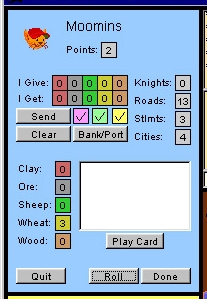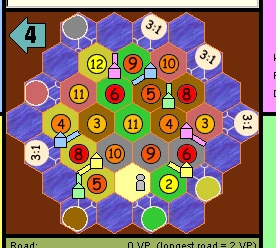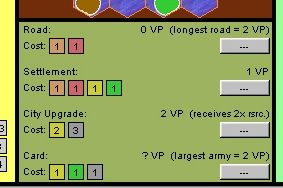
Player Status

The Board, the Island of Catan.

The Cost/buidling Panel
 Player Status |
 The Board, the Island of Catan. |
 The Cost/buidling Panel |
The Object of the game is to build and manage your resources to become the King of the Island of Catan. The person who reaches ten points first, wins the game. This game is not a war game, but a trading/strategy game. The board is random each game, which gives it infinite replayability.
The game is usually played with four players.
The Island of Catan is different each game, it is made up of hexes that represent the different types of terrain(resources).
 |
Wheat(4) |  |
Clay/Brick(3) |  |
Wood/Lumber(4) |  |
Water/Ocean(9) | ||
 |
Ore/Rock(3) |  |
Sheep(4) |  |
The Desert(1) |  |
3:1 Ports(4) |  |
Resource Port(5) one per resource type denoted by color, this is the brick port) |
Each of the five types of resource hexes are assigned numbers 2-12. These numbers represent the results of a 2d6 dice roll that is part of every turn in the game. When the number of any resource hex comes up, (such as with the 5 examples above) those hexes produce resources for anyone who has built a settlement or city on them.
The player can use resources gained over the course of the game to build the following:
 |
Settlement - produces one resource if it is on the intersection of any hex that produces that turn (has its number rolled) |
worth 1 victory point. Cost 1 sheep, 1 wheat, 1 wood and 1 clay to build. Must be built 2 road segments (whether there are roads there or not) away from existing settlements. You also must build settlements during the game (after the building phase) on your own road system. Hence you need to build roads before you can build any new settlements during the game. |
 |
City (upgrade) - produces two resources if it is on an intersection of any hex that produces that turn (has its number rolled) |
worth 2 victory points. cost 3 ore and 2 wheat to build Must be built in place of a settlement. Cities are upgrades to existing settlements only. |
 |
Roads - required to reach locations to build new settlements. | cost 1 clay and 1 lumber to build. Having the longest connected (and uninteruppted by other players settlements or cities), that is at least 5 in length is the Longest Road. This counts as two victory points. |
| * | Development cards - are similar to chance cards from monopoly. | cost 1 ore, 1 wheat and 1 sheep. These will be explained further below, the differnt types. |
Ports.
 |
Ports are there to help facilitate trade. The Island of Catan has limited resources that you
will be competing with the other players for. It is very likely you will find yourself short
of producing the resources you need to build and expand. One way to get resources
you do not have, is to trade. You can only trade on your turn, or with the person who's turn it is.
If you find players unwilling to trade(which you will, trust me), You can use ports to trade. There are two types of ports. the 3:1 (three to one) and the resource ports. The 3:1 port allows you to trade 3 of the same type of any resource, for one resource of your choice. Example: 3 wood for 1 clay, 3 wood for 1 sheep, 3 ore for 1 wood etc. The resource ports allow you to trade two of that type of resource(each port is denoted by color, the picture above shows the ore port), for any one resource. Hence if someone was built on the port -- noone is yet but the red player may later in the game -- they can trade 2 ore for any one resource, 2 ore for 1 wheat, 2 ore for 1 sheep etc. All players at all times can trade 4:1 to the bank, four of any one type for one of their choice. This isn't the best deal in town but sometimes its the only deal in town. |
The Robber 

The Island of Catan is not without villians (besides the other players of course!). The robber roams the island searching to steal precious resources. The robber starts the game in the desert (shown above.)
The robber comes into play when one of two things happen:
A '7' is rolled on the dice on any players turn. (note there are no '7's on any resource hexes, the '7' result from the die are reserved for the robber.
Also note that the robber steals from the rich. If a '7' is rolled any player who has 8 or more resources, must turn in half(rounded down) to the bank. He gets to choose what he discards. Moving the robber with a knight card does not cause anyone to turn in excess resources.
A player plays a development card he has purchased, the Knight card.
Once the robber needs to be moved, the player who's turn it is (rolled the 7 or played the knight card), gets to choose to move the robber to a hex of his choice. Any hex with the robber placed on it (such as the '5' hex above), will not produce any resources for the duration of the robber being there. So if the robber is on your hexes, you want him off it as soon as you can! The player moving the robber also selects one player who has a city/settlement on the hex he moves the robber to, and steals a random resource from them.
Development Cards
Development cards cost 1 ore, 1 wheat, and 1 sheep.
They are the equivalant of chance cards. When you buy a card, you keep it hidden
from your opponents. You can only play one card per turn and you can only
play a card the turn after you have bought it. The only exception would be if you
draw a victory point, since its in your hand if its your 10th point you win the game
without having to wait for your turn to come around again.
The types are as follows:
Game Play
The game starts out with the Building Phase
A random player starts the building phase. They build a settlement and a road from the settlement. Then it goes to the next player, This happens in reverse order. A,B,C,D,D,C,B,A.
The second settlement you place, determines which resources you start the game with. You start the game with one resource for every resource producing hex that is next to your settlement(max of 3).
When all four players have their first two settlements and roads built game play begins.
The Player's Turn
A player starts his turn in the following sequence: